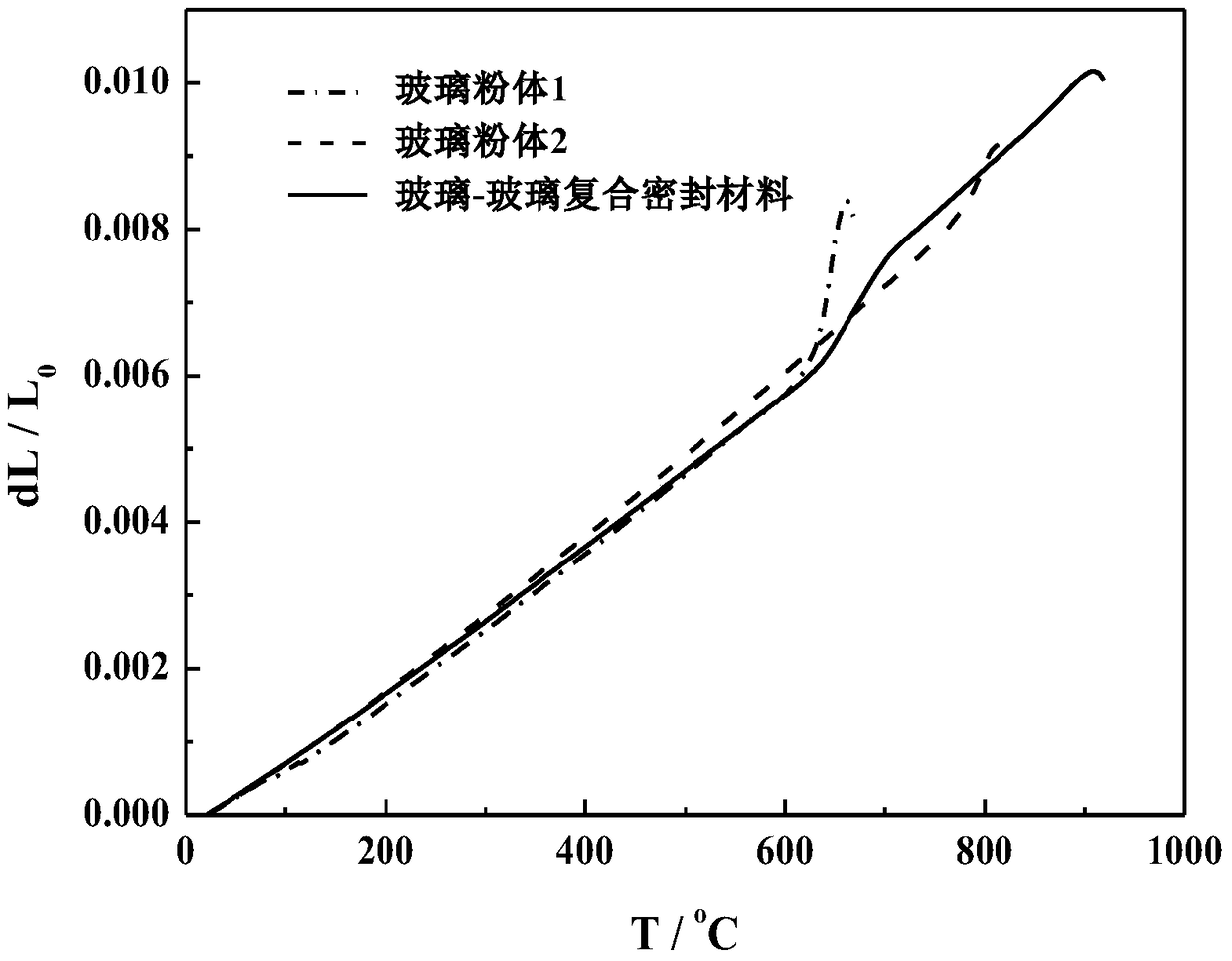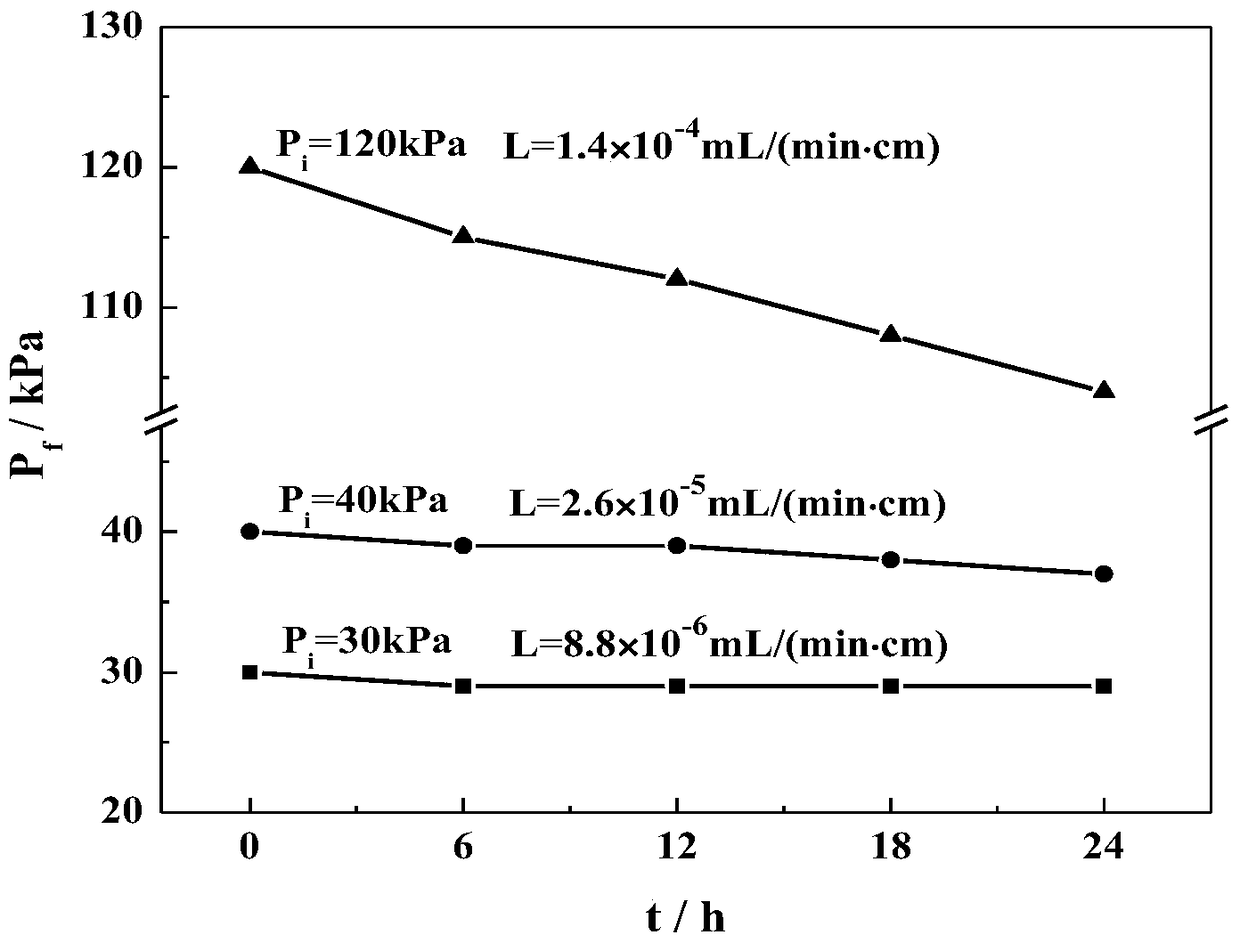Glass-glass composite sealing material and its preparation method and application
A technology of composite sealing and sealing material, applied in the field of materials, can solve the problems of poor compatibility, serious chemical reaction, and narrow temperature range of sealing materials, and achieve the effects of avoiding poisoning, simple preparation method and avoiding poor compatibility.
- Summary
- Abstract
- Description
- Claims
- Application Information
AI Technical Summary
Problems solved by technology
Method used
Image
Examples
Embodiment 1
[0037] (1) Preparation of glass powder:
[0038] Preparation of low softening point glass: SiO by molar ratio 2 : Na 2 O: CaO: Al 2 o 3 : La 2 o 3 =50:25:20:3:2 Weigh SiO 2 、Na 2 CO 3 , CaCO 3 、Al 2 o 3 and La 2 o 3 . The raw materials were ball milled on a planetary ball mill for 24 hours, and the mixture was dried and placed in a platinum crucible, and then melted at high temperature in a crucible frit furnace. The temperature rise system adopted is: raise the temperature to 1100°C at a heating rate of 10°C / min and hold it for 1 hour to ensure the complete decomposition of carbonate in the raw material; then raise the temperature to 1300°C at a heating rate of 5°C / min and keep the temperature for 2 hours To ensure that the glass is completely melted; take out the crucible from the furnace and quickly pour it into cold water for quenching to obtain a glass frit. The glass frit was dried at 60° C., crushed, ground, and passed through a 400-mesh sieve to obtain a...
Embodiment 2
[0043] (1) Preparation of glass powder:
[0044] Preparation of low softening point glass: SiO by molar ratio 2 :B 2 o 3 :CaO:Al 2 o 3 : CeO 2 =28:20:45:5:2 Weigh SiO 2 、H 3 BO 3 , CaCO 3 、Al 2 o 3 and CeO 2 . The raw materials were ball milled on a planetary ball mill for 24 hours, and the mixture was dried and placed in a platinum crucible, and then melted at high temperature in a crucible frit furnace. The heating system adopted is: raise the temperature to 1100°C at a heating rate of 10°C / min and hold it for 1 hour to ensure the complete decomposition of carbonate and boric acid in the raw materials; then raise the temperature to 1250°C at a heating rate of 5°C / min, Keep the temperature constant for 2 hours to ensure that the glass is completely melted; take out the crucible from the furnace and quickly pour it into cold water for quenching to obtain a glass frit. The glass frit was dried at 60° C., crushed, ground, and passed through a 400-mesh sieve to obta...
Embodiment 3
[0049] (1) Preparation of glass powder:
[0050] Preparation of low softening point glass: SiO by molar ratio 2 :K 2 O: CaO: Al 2 o 3 : Sm 2 o 3 =43:25:20:10:2 Weigh SiO 2 、K 2 CO 3 , CaCO 3 、Al 2 o 3 and Sm 2 o 3 . The raw materials were ball milled on a planetary ball mill for 24 hours, and the mixture was dried and placed in a platinum crucible, and then melted at high temperature in a crucible frit furnace. The heating system adopted is: raise the temperature to 1100°C at a heating rate of 10°C / min and hold it for 1 hour to ensure the complete decomposition of the carbonate in the raw material; then raise the temperature to 1300°C at a heating rate of 5°C / min and keep the temperature for 2 hours To ensure that the glass is completely melted; take out the crucible from the furnace and quickly pour it into cold water for quenching to obtain a glass frit. The glass frit was dried at 60° C., crushed, ground, and passed through a 400-mesh sieve to obtain a glass ...
PUM
| Property | Measurement | Unit |
|---|---|---|
| transition temperature | aaaaa | aaaaa |
| softening point | aaaaa | aaaaa |
Abstract
Description
Claims
Application Information
 Login to View More
Login to View More - R&D
- Intellectual Property
- Life Sciences
- Materials
- Tech Scout
- Unparalleled Data Quality
- Higher Quality Content
- 60% Fewer Hallucinations
Browse by: Latest US Patents, China's latest patents, Technical Efficacy Thesaurus, Application Domain, Technology Topic, Popular Technical Reports.
© 2025 PatSnap. All rights reserved.Legal|Privacy policy|Modern Slavery Act Transparency Statement|Sitemap|About US| Contact US: help@patsnap.com



